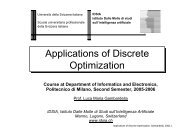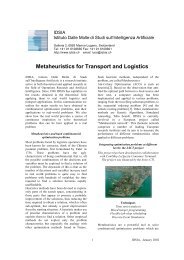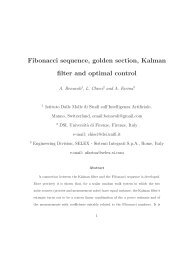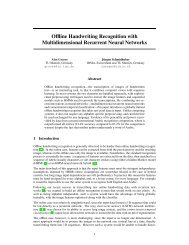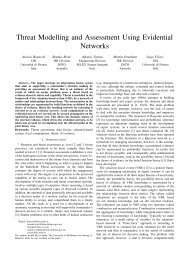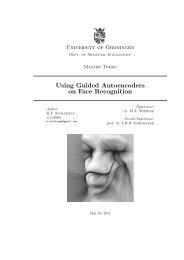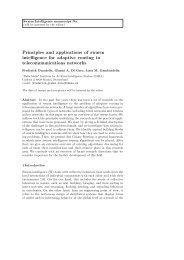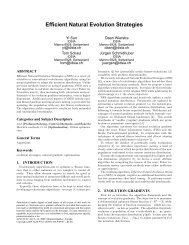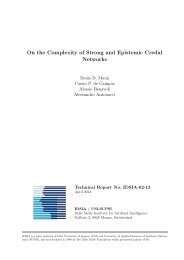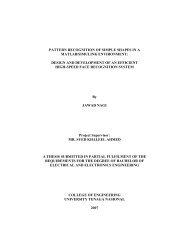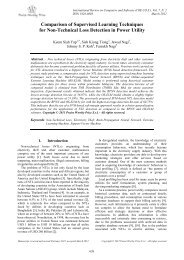AntHocNet: an Ant-Based Hybrid Routing Algorithm for ... - CiteSeerX
AntHocNet: an Ant-Based Hybrid Routing Algorithm for ... - CiteSeerX
AntHocNet: an Ant-Based Hybrid Routing Algorithm for ... - CiteSeerX
Create successful ePaper yourself
Turn your PDF publications into a flip-book with our unique Google optimized e-Paper software.
to the shared ch<strong>an</strong>nel is controlled by protocols at the Medium Access Control<br />
layer (MAC), such as ANSI/IEEE 802.11 DCF [7] (the most commonly used in<br />
MANETs), which in their turn create extra overhead.<br />
In this work we propose <strong><strong>Ant</strong>HocNet</strong>, a new MANET routing algorithm based<br />
on ideas from <strong>an</strong>t-based routing. For wired networks, a number of successful<br />
<strong>an</strong>t-based routing algorithms exist (eg. ABC [14] <strong>an</strong>d <strong>Ant</strong>Net [3]). They are<br />
based on the pheromone trail laying-following behavior of real <strong>an</strong>ts <strong>an</strong>d the<br />
related framework of <strong>an</strong>t colony optimization (ACO) [4]. The main idea is to<br />
continuously sample possible paths with <strong>an</strong>t-like agents, <strong>an</strong>d to indicate the<br />
quality of paths by me<strong>an</strong>s of artificial pheromone variables. Multiple paths are<br />
made available this way, <strong>an</strong>d data packets are stochastically spread over them<br />
following the pheromone values. <strong>Ant</strong>-based routing algorithms exhibit a number<br />
of desirable properties <strong>for</strong> MANET routing: they work in a distributed way, are<br />
highly adaptive, are robust, <strong>an</strong>d provide automatic load bal<strong>an</strong>cing.<br />
In this paper, we aim to propose <strong>an</strong> algorithm which c<strong>an</strong> work efficiently in<br />
MANETs, while still maintaining those properties which make <strong>an</strong>t-based algorithms<br />
so appealing. The rest of this paper is org<strong>an</strong>ized as follows. In section 2<br />
we describe related work in MANET <strong>an</strong>d <strong>an</strong>t-based routing. Section 3 contains<br />
the description of our algorithm <strong>an</strong>d in section 4 we present simulation results.<br />
2 Related work: MANET routing <strong>an</strong>d <strong>an</strong>t-based routing<br />
The specific challenges <strong>an</strong>d possible applications of MANETs have made this a<br />
very popular research area, <strong>an</strong>d a lot of routing algorithms have been proposed.<br />
People traditionally classify these algorithms as either proactive or reactive. In<br />
purely proactive protocols (e.g., DSDV [11]) nodes try to maintain at all times<br />
routes to all other nodes. This me<strong>an</strong>s that they need to keep track of all topology<br />
ch<strong>an</strong>ges, which c<strong>an</strong> become difficult if there are a lot of nodes or if they are very<br />
mobile. There<strong>for</strong>e, reactive protocols (e.g., AODV [12] or DSR [8]) are in general<br />
more scalable (see [2]). In these protocols, nodes only gather routing in<strong>for</strong>mation<br />
on dem<strong>an</strong>d: only when they have data <strong>for</strong> a certain destination they construct<br />
a path, <strong>an</strong>d only when the path becomes infeasible they search a new path.<br />
In this way they greatly reduce the routing overhead, but they c<strong>an</strong> suffer from<br />
oscillations in per<strong>for</strong>m<strong>an</strong>ce since they are never prepared <strong>for</strong> disruptive events.<br />
<strong>Hybrid</strong> algorithms like ZRP [6] have both a proactive <strong>an</strong>d a reactive component,<br />
in order to try to combine the best of both worlds.<br />
Most of the algorithms are single path: at <strong>an</strong>y time, they use only one path<br />
between source <strong>an</strong>d destination. Multipath routing (see [10] <strong>for</strong> <strong>an</strong> overview)<br />
offers <strong>an</strong> interesting alternative in terms of link failure robustness <strong>an</strong>d load bal<strong>an</strong>cing.<br />
Some algorithms create multiple paths at path setup time, <strong>an</strong>d use the<br />
best of these until it fails, after which they switch to the second best <strong>an</strong>d so<br />
on (e.g., AODV-BR [9]). A problem with this way of working is that alternative<br />
paths are often infeasible by the time they need to be used. Moreover, when only<br />
the best path is used, one looses the opportunity to spread data packets over<br />
the different paths, a practice which c<strong>an</strong> improve the network throughput.<br />
2



